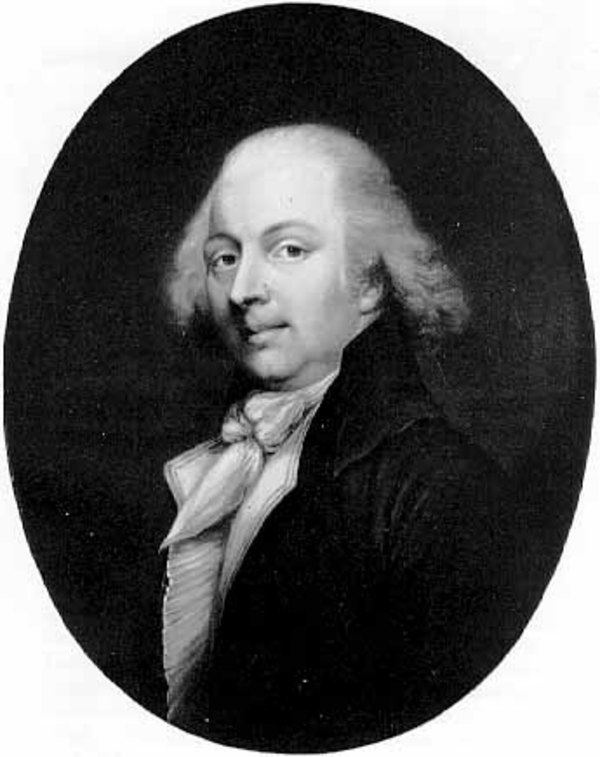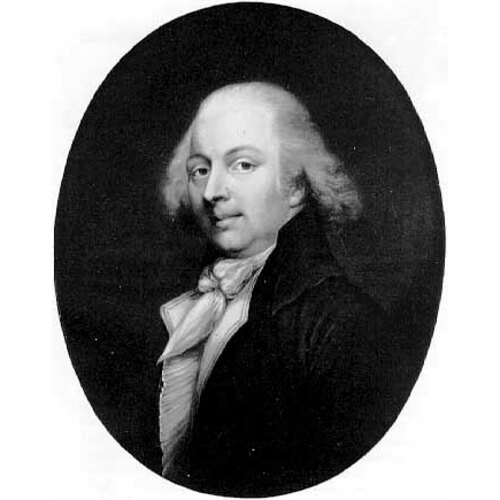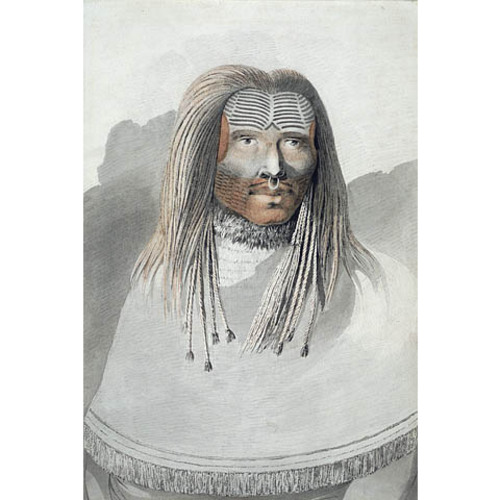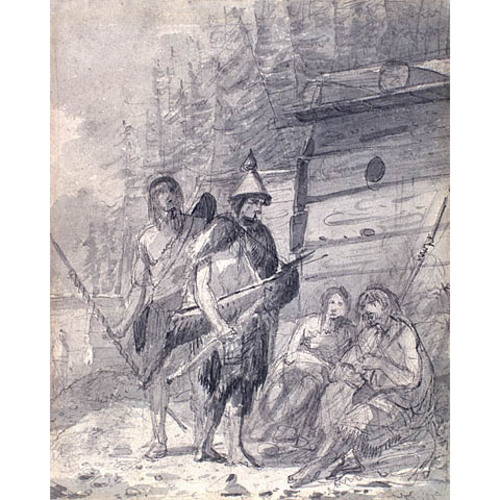
Source: Courtesy of Wikimedia Commons
WEBBER, JOHN (known in Switzerland as Johann Wäber, but he signed John Webber), artist on James Cook’s third Pacific voyage; b. 6 Oct. 1751 in London, England; d. 29 April 1793 in London.
John Webber’s father, Abraham Wäber, was a Swiss sculptor who moved to London, changed his name to Webber, and in 1744 married a Mrs Mary Quant. John, the second of six children and probably the eldest surviving, was sent to Bern in 1757 or 1758 to be raised by Rosina Wäber, a maiden aunt. Encouraged in his early aptitude for drawing, he was placed under Johann Ludwig Aberli, a landscape and portrait painter. In 1770 he was sent to Paris, where he studied under Johann Georg Wille. His French drawings show an inclination toward the rural picturesque.
Webber returned to London in 1775 and found employment decorating house interiors for a speculative builder. On the urging of his employer, he displayed his work at the 1776 exhibition of the Royal Academy of Arts. His views of Parisian environs and a portrait of his brother caught the eye of Daniel Carl Solander, assistant to the naturalist Joseph Banks*. It was probably through the agency of Banks that Webber, as Cook wrote, was “pitched upon” for the explorer’s third Pacific voyage, to supply drawings of “the most memorable scenes of our transactions” that would supplement “the unavoidable imperfections” of the written account.
The expedition departed in July 1776. Webber sketched as the ships made their way across the Pacific. Two years later, while searching the northwest coast of America for a passage to the Atlantic, Cook’s vessels spent four weeks refitting at Nootka Sound (B.C.). There Webber found the Indians (Nootkas) to be “wretched and wild in nature, living principally by fishing and hunting, and the country is covered with pine trees.” Drawing “every thing that was curious both within and without doors,” he later wrote that he had found at Yuquot, one of the villages at Nootka, “an inside which would furnish me with sufficient matter to convey a perfect Idea of the mode these people live in.” He began sketching the room’s two large carved and painted figures when a man, seemingly displeased, approached with a long knife and placed a mat “in such a manner as to hinder my having any further sight of them. Being certain of no further opportunity to finish my Drawing & the object too interesting for leaving unfinished, I considered a little bribery . . . and accordingly made an offer of a button from my coat, which when of metal they are much pleased with. This instantly produced the desired effect.” It took all of Webber’s buttons to enable him to finish.
Webber’s efforts on Cook’s expedition were well received and rewarded. After returning to London in August 1780, he showed his 200 sketches to George III, the Earl of Sandwich, and Fanny Burney, a noted writer. In addition to the able-bodied seaman’s pay Cook had slipped him during the voyage, he received £187 for mess expenses, a back salary of 400 guineas, and a commission to supervise the engraving of 61 of his drawings for the official journals at £250 per annum. Printing was slow, and George Nicol, the king’s bookseller, charged Webber with studied delay. His pay ended only in June 1785.
Webber revisited Bern in 1787, and he sketched in Derbyshire and Wales. Having been made an associate of the Royal Academy in 1785, in 1791 he was elected a full member. He printed a series of his own etchings of the voyage, and both Francesco Bartolozzi and William Byrne engraved his Death of Cook. Toward 1793 his health declined, and he died in his residence on Oxford Street, at the age of 41, of a kidney disease.
Although none of Webber’s pictures rises to distinction, they have on the whole a consistently high quality. His depictions of Nootka Sound, of which there seem to be 29 extant, present about 17 different subjects ranging from coastal profiles to a dead sea otter. The most important drawings, those of Nootkas, the inside and outside of their houses, and their masks and rattles, are of inestimable ethnological value. Six were engraved for the published journal, which was very favourably received and ran through several printings.
BL, Add. mss 33977, ff.217–19; Egerton mss 2180, ff.112–13. PRO, Adm. 17/7. St George’s Church (London), Registers of baptisms, burials, and marriages. Staatsarchiv des Kantons Bern (Bern, Switzerland), Nachlass Sigmund Wagner. James Cook and James King, A voyage to the Pacific Ocean . . . (3v. and atlas, London, 1784). Journals of Captain James Cook (Beaglehole), III. DNB. Historischer Verein des Kantons Bern, Biographien-Kommission, Sammlung Bernischer Biographien (5v., Bern, 1887–1906), II, 295–307. Schweizerisches Künstler-Lexikon, ed. Carl. Brun (4v., Frauenfeld, Switzerland, 1905–17; repr. Nendeln, Liechtenstein, 1967), III, 409–10. D. I. Bushnell, Drawings by John Webber of natives of the northwest coast of America, 1778 (with 12 plates) (Washington, 1928). J. J. Horner and Sigmund Wagren, “Leben Johann Webers von Bern,” Künstler-Gesellschaft in Zurich, Neujahrstück, XVII (1821), 1–13.
Cite This Article
Douglas Cole, “WEBBER, JOHN (Johann Wäber),” in Dictionary of Canadian Biography, vol. 4, University of Toronto/Université Laval, 2003–, accessed December 19, 2025, https://www.biographi.ca/en/bio/webber_john_4E.html.
The citation above shows the format for footnotes and endnotes according to the Chicago manual of style (16th edition). Information to be used in other citation formats:
| Permalink: | https://www.biographi.ca/en/bio/webber_john_4E.html |
| Author of Article: | Douglas Cole |
| Title of Article: | WEBBER, JOHN (Johann Wäber) |
| Publication Name: | Dictionary of Canadian Biography, vol. 4 |
| Publisher: | University of Toronto/Université Laval |
| Year of publication: | 1979 |
| Year of revision: | 1979 |
| Access Date: | December 19, 2025 |





